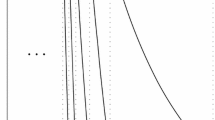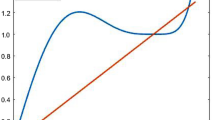Abstract
The best approximation of a matrix by a low-rank matrix can be obtained by the singular value decomposition. For large-sized matrices this approach is too costly. Instead one may use a block decomposition. Approximating the small submatrices by low-rank matrices and agglomerating them into a new, coarser block decomposition, one obtains a recursive method. The required computation work is \(O(rnm)\) where \(r\) is the desired rank and \(n\times m\) is the size of the matrix. The paper discusses the new error estimates for \(A-B\) and \(M-A\) where \(A\) is the result of the recursive truncation applied to \(M\), while \(B\) is the best approximation.

Similar content being viewed by others
Notes
The algorithm is completely different from spectral divide and conquer methods, as they are analysed, e.g., in [10] and the literature cited therein.
The applications to hierarchical matrices are cheaper because of their special structures.
In principle, the cost must depend on the underlying machine precision. The constants also depend on the implemented version of the algorithms etc. We introduce these explicit numbers to be able to indicate the cost of the later algorithm quantitatively. Otherwise, only statements using \(\mathcal {O}(\ldots )\) are possible.
We use the term ‘orthogonal matrix’ also for rectangular matrices whose columns are pairwise orthonormal.
The possible case of \({\text {rank}}(A)<r\) is included since we may choose \(\lambda _{i}=0\).
The particular values are \(\mu =50\) and \(r=25.\) For \(\omega =0,\) the choice of \(2r=\mu \) yields the worse case \(q=(1+\sqrt{5})/2\). However, for larger values of \(\omega \), the results are rather independent of \(\mu \) and \(r\).
For \(\omega \ge 12\), the worse case is again given by (4.6).
\(\chi \circ \delta \) is the Hadamard product (entry-wise product) defined by \(\left( \chi \circ \delta \right) _{ij}=\chi _{ij} \delta _{ij}\).
For subspaces \(V\subset \mathbb {R}^{I}\) and \(W\subset \mathbb {R}^{J},\) the tensor space \(V\otimes W\) is defined by \({\text {span}}\{vw^{\mathsf {T}}:v\in V,w\in W\}\) (cf. [7, Remark 1.3]).
References
Bebendorf, M., Hackbusch, W.: Existence of \(\cal {H}\)-matrix approximants to the inverse FE-matrix of elliptic operators with \({L}^{\infty }\)-coefficients. Numer. Math. 95, 1–28 (2003)
Demmel, J., Gu, M., Eisenstat, S., Slapničar, I., Veselić, K., Drmač, Z.: Computing the singular value decomposition with high relative accuracy. Linear Alg. Appl 299, 21–80 (1999)
Drmač, Z.: Accurate computation of the product-induced singular value decomposition with applications. SIAM J. Numer. Anal. 35, 1969–1994 (1998)
Golub, G.H., Van Loan, C.F.: Matrix computations, 3rd edn. The Johns Hopkins University Press, Baltimore (1996)
Grasedyck, L., Hackbusch, W.: Construction and arithmetics of \(\cal {H}\)-matrices. Computing 70, 295–334 (2003)
Hackbusch, W.: Hierarchische Matrizen—Algorithmen und Analysis, Springer, Berlin, 2009—Hierarchical Matrices—Algorithms and Analysis. Springer, Berlin (2015, to appear)
Hackbusch, W.: Tensor Spaces and Numerical Tensor Calculus. SCM. Springer, Berlin (2012)
Hackbusch, W., Khoromskij, B., Kriemann, R.: Hierarchical matrices based on a weak admissibility criterion. Computing 73, 207–243 (2004)
Kandler, U., Schröder, C.: Spectral error bounds for Hermitian inexact Krylov methods. Preprint 11–2014, Institute of Mathematics, Technische Universität Berlin (2014)
Nakatsukasa, Y., Higham, N.J.: Stable and efficient divide and conquer algorithms for the symmetric eigenvalue decomposition and the SVD. SIAM J. Sci. Comput. 35, A1325–A1349 (2013)
Schmidt, E.: Zur Theorie der linearen und nichtlinearen Integralgleichungen. I. Teil: Entwicklung willkürlicher Funktionen nach Systemen vorgeschriebener. Math. Ann. 63, 433–476 (1907)
Acknowledgments
We thank Dr. R. Kriemann for providing the numerical tests.
Author information
Authors and Affiliations
Corresponding author
Rights and permissions
About this article
Cite this article
Hackbusch, W. New estimates for the recursive low-rank truncation of block-structured matrices. Numer. Math. 132, 303–328 (2016). https://doi.org/10.1007/s00211-015-0716-7
Received:
Revised:
Published:
Issue Date:
DOI: https://doi.org/10.1007/s00211-015-0716-7




